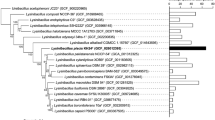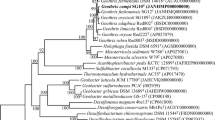Abstract
A Gram-stain negative, non-motile, and yellow-coloured bacterium, designated 17J28-26T, was isolated from soil in Jeju Island, Korea. Phylogenetic analyses based on 16S rRNA gene sequences revealed that strain 17J28-26T formed a distinct lineage within the family Chitinophagaceae (order Chitinophagales, class Chitinophagia), and is closely related to Flavisolibacter ginsenosidimutans (96.8% 16S rRNA gene sequence similarity), and Flavisolibacter ginsengisoli (96.6%). Growth was observed at 18–37 °C (optimum 30 °C) in R2A medium at pH 7.0. The major cellular fatty acids of strain 17J28-26T were summed feature 3 (C16:1 ω6c and/or C16:1 ω7c), and iso-C15:0. The predominant respiratory quinone was MK-7. The major polar lipid was identified as phosphatidylethanolamine. Based on biochemical, chemotaxonomic and phylogenetic characteristics, strain 17J28-26T represents a novel bacterial species within the family Chitinophagaceae, for which the name Flavisolibacter galbus sp. nov. is proposed. The type strain of Flavisolibacter galbus is 17J28-26T (= KCTC 62222T = JCM 33203T).



Similar content being viewed by others
Abbreviations
- L:
-
Lipid
- PL:
-
Phospholipid
- APL:
-
Aminophospholipid
- PE:
-
Phosphatidylethanolamine (PE)
References
Baik KS, Kim MS, Lee JH, Lee SS, Im WT, Seong CN (2014) Flavisolibacter rigui sp. nov., isolated from freshwater of an artificial reservoir and emended description of the genus Flavisolibacter. Int J Syst Evol Microbiol 64:4038–4042
Bates RG, Bower VE (1956) Alkaline solutions for pH control. Anal Chem 28:1322–1324
Cappuccino JG, Sherman N (2002) Microbiology- A laboratory manual, 6th edn. Pearson Education, Inc. Benjamin Cummings, California
Felsenstein J (1985) Confidence limit on phylogenies: an approach using the bootstrap. Evolution 39:783–791
Fitch MW (1971) Toward defining the course of evolution: minimum change for a specific tree topology. Syst Zoo 20:406–416
Gomori G (1955) Preparation of buffers for use in enzyme studies. Methods Enzymol 1:138–146
Hiraishi A, Ueda Y, Ishihara J, Mori T (1996) Comparative lipoquinone analysis of influent sewage and activated sludge by high performance liquid chromatography and photodiode array detection. J Gen Appl Microbiol 42:457–469
Jeon YS, Lee K, Park SC, Kim BS, Cho YJ, Ha SM, Chun J (2014) EzEditor: a versatile sequence alignment editor for both rRNA- and protein-coding genes. Int J Syst Evol Microbiol 64:689–691
Kämpfer P, Lodders N, Falsen E (2011) Hydrotalea flava gen. nov., sp. nov., a new member of the phylum Bacteroidetes and allocation of the genera Chitinophaga, Sediminibacterium, Lacibacter, Flavihumibacter, Flavisolibacter, Niabella, Niastella, Segetibacter, Parasegetibacter, Terrimonas, Ferruginibacter, Filimonas and Hydrotalea to the family Chitinophagaceae fam. nov. Int J Syst Evol Microbiol 61:518–523
Kim MK, Im W-T, Ohta H, Lee M, Lee S-T (2005) Sphingopyxis granuli sp. nov., a β-glucosidase-producing bacterium in the family Sphingomonadaceae in a-4 subclass of the Proteobacteria. J Microbiol 43:152–157
Kim DU, Lee H, Lee S, Kim SG, Park AY, Ahn JH, Ka JO (2018) Flavisolibacter metallilatus sp. nov., isolated from an automotive air conditioning system and emended description of the genus Flavisolibacter. Int J Syst Evol Microbiol 68:917–923
Komagata K, Suzuki K (1987) Lipid and cell-wall analysis in bacterial systematics. Methods Microbiol 19:161–207
Kumar S, Stecher G, Tamura K (2016) MEGA7: molecular evolutionary genetics analysis version 7.0 for bigger datasets. Mole Bio Evol 33:1870–1874
Lee J, Kang M, Kim G, Lee C, Lim S, Lee J, Roh S, Kang H, Ha J, Bae S, Jung H, Kim M (2016) Flavisolibacter tropicus sp. nov., isolated from tropical soil. Int J Syst Evol Microbiol 66:3413–3419
Minnikin DE, O’Donnell AG, Goodfellow M, Alderson G, Athalye M, Schaal A, Parlett JH (1984) An integrated procedure for the extraction of bacterial isoprenoid quinones and polar lipids. J Microbiol Methods 2:233–241
Saitou N, Nei M (1987) The neighbor-joining method: a new method for reconstructing phylogenetic trees. Mol Biol Evol 4:406–425
Sasser M (1990) Identification of bacteria by gas chromatography of cellular fatty acids. MIDI Technical Note 101. Newark, DE: MIDI Inc
Stackebrandt E, Goebel BM (1994) Taxonomic note: a place for DNA-DNA reassociation and 16S rRNA sequence analysis in the present species definition in bacteriology. Int J Syst Evol Microbiol 44:846–849
Thompson JD, Gibson TJ, Plewniak F, Jeanmougin F, Higgins DG (1997) The ClustalX windows interface: flexible strategies for multiple sequence alignment aided by quality analysis tools. Nucleic Acids Res 24:4876–4882
Weisburg WG, Barns SM, Pellerier DA, Lane DJ (1991) 16S ribosomal DNA amplification for phylogenetic study. J Bacteriol 173:697–703
Yoon MH, Im WT (2007) Flavisolibacter ginsengiterrae gen. nov., sp. nov. and Flavisolibacter ginsengisoli sp. nov., isolated from ginseng cultivating soil. Int J Syst Evol Microbiol 57:1834–1839
Yoon SH, Ha SM, Kwon S, Lim J, Kim Y, Seo H, Chun J (2017) Introducing EzBioCloud: a taxonomically united database of 16S rRNA and whole genome assemblies. Int J Syst Evol Microbiol 67:1613–1617
Zhao Y, Liu Q, Kang MS, Jin F, Yu H, Im WT (2015) Flavisolibacter ginsenosidimutans sp. nov., with ginsenoside-converting activity isolated from soil used for cultivating ginseng. Int J Syst Evol Microbiol 65:4868–4872
Acknowledgement
This work was supported by a research grant from Seoul Women’s University (2018) and by a grant from the National Institute of Biological Resources (NIBR), funded by the Ministry of Environment (MOE) of the Republic of Korea (NIBR201801204).
Author information
Authors and Affiliations
Contributions
All authors equally contributed in this work.
Corresponding author
Ethics declarations
Conflict of interest
All authors certify that there is no conflict of interest with any financial organization regarding the material discussed in the manuscript.
Additional information
Publisher's Note
Springer Nature remains neutral with regard to jurisdictional claims in published maps and institutional affiliations.
Rights and permissions
About this article
Cite this article
Maeng, S.H., Kim, M.K., Jang, J.H. et al. Flavisolibacter galbus sp. nov., isolated from soil in Jeju Island. Antonie van Leeuwenhoek 112, 1559–1565 (2019). https://doi.org/10.1007/s10482-019-01282-8
Received:
Accepted:
Published:
Issue Date:
DOI: https://doi.org/10.1007/s10482-019-01282-8




